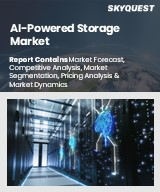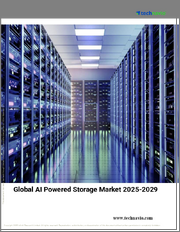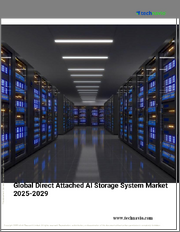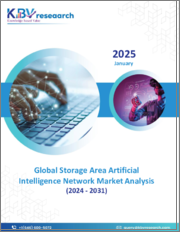
|
시장보고서
상품코드
1837516
AI 탑재 스토리지 시장 : 구성 요소별, 스토리지 유형별, 조직 규모별, 배포 모드별, 최종 사용자 산업별, 용도별 세계 예측(2025-2032년)AI-Powered Storage Market by Component, Storage Type, Organization Size, Deployment Mode, End-User Industry, Application - Global Forecast 2025-2032 |
||||||
AI 탑재 스토리지 시장은 2032년까지 연평균 복합 성장률(CAGR) 27.42%를 나타내 1,297억 6,000만 달러의 성장이 예측되고 있습니다.
| 주요 시장 통계 | |
|---|---|
| 기준 연도(2024년) | 186억 7,000만 달러 |
| 추정 연도(2025년) | 238억 5,000만 달러 |
| 예측 연도(2032년) | 1,297억 6,000만 달러 |
| CAGR(%) | 27.42% |
수동 용량에서 AI 워크로드 및 기업 데이터 목표를 추진하는 지능형 인프라로 이동하는 스토리지의 전략적 필수 사항 프레임 워크
스토리지가 수동 용량에서 능동적이고 지능적인 인프라로 진화함에 따라 기업이 데이터를 저장, 보호 및 가치를 이끌어내는 방법이 재구성되고 있습니다. 본 보고서에서는 AI를 활용한 스토리지를 둘러싼 현대 상황을 정리하고 고성능 워크플로우와 데이터 경제성 향상을 가능하게 하는 하드웨어의 진화, 소프트웨어의 인텔리전스, 서비스 모델의 상호관계에 대해 개략적으로 설명합니다. 리더는 스토리지를 백엔드의 범용성이 아닌 용도 성능, AI 모델의 교육 효율성, 규정 준수에 영향을 미치는 전략적 레이어로 파악해야 합니다.
이러한 배경에서 NVMe 프로토콜, Software-Defined Management, 통합 보안 툴 등의 기술 혁신은 낮은 대기 시간, 높은 처리량 및 원활한 확장성에 대한 운영 요구 사항과 융합하고 있습니다. 의사결정자는 이러한 진전이 클라우드, On-Premise 및 하이브리드 배포의 아키텍처 선택에 어떤 영향을 미치는지, 조달 우선순위, 인재 투자 및 파트너십에 어떻게 반영되는지 검토해야 합니다. 이 소개는 AI 워크로드로 인한 경쟁적 필수 요건과 변화를 제한하거나 가능하게 하는 운영 현실에 주목하여 분석의 나머지 부분에 대한 전략적 렌즈를 확립합니다.
성능, 소프트웨어 인텔리전스, 하이브리드 배포 선호도 및 공급망의 탄력성 융합이 스토리지 경쟁 우위를 어떻게 재정의하는지
스토리지 상황은 공급업체 전략, 솔루션 아키텍처 및 구매자의 기대를 재정의하는 일련의 변화를 맞이합니다. 첫째, AI와 실시간 분석을 통한 성능 및 대기 시간 요구 사항은 NVMe 기반의 솔리드 스테이트 기술과 처리량 및 예측 가능한 성능을 선호하는 분산 아키텍처의 채택을 가속화하고 있습니다. 동시에 소프트웨어 인텔리전스는 자동화, 예측 유지보수 및 정책 기반 데이터 배치를 하드웨어 플랫폼에 계층화하여 효율성을 높이고 운영 오버헤드를 줄일 수 있습니다.
둘째, On-Premise 배포를 제어하는 동시에 클라우드 경제의 유연성을 요구하는 조직은 소비 모델을 다양화하고 있습니다. 하이브리드 접근법과 에지 확장이 널리 보급되어 오케스트레이션과 통합 관리가 중요한 차별화 요인으로 부상하고 있습니다. 암호화, 불변 스냅샷, 통합 위협 감지 등이 스토리지 스택에 통합되고 있습니다. 마지막으로 공급망의 탄력성과 구성 요소 조달 전략은 조달 주기와 공급업체 관계에 영향을 미치고 있으며, 구매자에게 위험 재평가, 공급업체 다양화, 컨티즌시 플랜 구축을 촉진하고 있습니다. 이러한 변화가 결합되어 데이터 액세스 속도, 소프트웨어 주도 차별화, 시장 민첩성이 시장 주도권을 좌우하는 새로운 경쟁 지형이 형성됩니다.
중층 관세 조치와 무역 정책 불확실성이 공급자 전략, 조달 타이밍 및 스토리지의 총 비용 감도를 어떻게 재구성하는지 이해합니다.
새로운 무역 정책 역학과 관세 조치는 스토리지 공급망, 부품 조달 및 공급업체의 가격 전략에 중대한 영향을 미칩니다. 관세 조정은 공급업체의 다양화, 제조 현지화, 비용 변동 및 납기 지연을 완화하기 위한 재고 계획을 강조합니다. 이에 따라 많은 솔루션 제공업체와 통합업체는 수입 관세주기에 노출되는 기회를 줄이기 위해 NAND 플래시, 컨트롤러 및 자기 미디어와 같은 중요한 구성 요소의 BOM 전략을 재평가하고 다른 조달 경로를 모색하고 있습니다.
관세의 누적 영향은 조달 일정에도 파급되고, 리드 타임의 장기화와 잠재적인 비용 패스 스루를 통해 구매자는 계약 구조를 조정하고 협상력을 유지하기 위해 멀티 소싱을 고려하게됩니다. 게다가 관세와 관련된 불확실성은 하드웨어 출하에서 수익을 분리하고, 보다 가치 있는 서비스 계약 및 소프트웨어 라이선싱으로의 전환을 촉구하며, 공급업체가 마진을 보호하면서 고객에게 예측 가능한 운영 비용을 제공할 수 있도록 합니다. 운영 관점에서 기업은 관세 시나리오와 운송 중단에 대한 명확한 민감도로 총 소유 비용을 계산하고 있으며, 그 결과 업데이트 주기, 기술 로드맵 및 On-Premise 용량 및 클라우드 기반 대안에 대한 의사 결정에 영향을 미칩니다. 궁극적으로 관세 환경은 공급망 투명성과 계약 유연성의 전략적 가치를 강화합니다.
구성 요소, 스토리지 유형, 조직 프로파일, 배포, 산업, 핵심 스토리지 용도에 걸친 수요 및 솔루션 설계 세분화
뉘앙스가 풍부한 세분화의 프레임워크는 수요의 역학과 기술의 선택이 시장의 다른 차원에서 어떻게 다른지를 보여줍니다. 구성 요소에 따라 구매자는 하드웨어, 서비스 및 소프트웨어를 구별합니다. 서비스에는 관리 운영 및 전문 계약이 포함되며, 소프트웨어에는 데이터 배포 및 수명 주기 정책을 오케스트레이션하는 분석 도구, 보안 제품군 및 스토리지 관리 플랫폼이 포함됩니다. 스토리지 유형에 따라 의사 결정자는 하드 디스크 드라이브, 하이브리드 드라이브, SSD 중에서 선택하며 기존의 하드 디스크 제품은 SAS와 SATA 인터페이스에 의해 더욱 세분화되고 솔리드 스테이트 설계는 NVMe SSD와 SATA SSD 프로토콜로 나뉘어 다양한 성능과 비용 포인트를 지원합니다.
목차
제1장 서문
제2장 조사 방법
제3장 주요 요약
제4장 시장 개요
제5장 시장 인사이트
- 실시간 데이터 계층화 및 압축 최적화를 위한 생성형 AI 알고리즘의 채용
- 스토리지 인프라의 다운타임을 최소화하기 위한 AI 구동형 예측 유지보수 도입
- 적응 형 캐시 및 워크로드 우선 순위 지정을위한 신경 네트워크 모델 구현
- IoT 용도에서 에지 스토리지 가속화를 위한 디바이스 내 머신러닝 통합
- 딥러닝 프레임워크를 활용한 데이터 중복 제거와 에러 정정의 자동화
- 스토리지 어레이에서 자율적인 위협 검출을 가능하게 하는 AI 탑재 보안 레이어 개발
- 강화 학습을 활용한 퍼포먼스 스케일링에 의한 자기 최적화 스토리지 패브릭의 출현
제6장 미국 관세의 누적 영향(2025년)
제7장 AI의 누적 영향(2025년)
제8장 AI 탑재 스토리지 시장 : 구성 요소별
- 하드웨어
- 서비스
- 매니지드 서비스
- 전문 서비스
- 소프트웨어
- 분석 소프트웨어
- 보안 소프트웨어
- 스토리지 관리 소프트웨어
제9장 AI 탑재 스토리지 시장 : 스토리지 유형별
- 하드 디스크 드라이브
- SAS 인터페이스
- SATA 인터페이스
- 하이브리드 드라이브
- SSD
- NVMe SSD
- SATA SSD
제10장 AI 탑재 스토리지 시장 : 조직 규모별
- 대기업
- 중소기업
제11장 AI 탑재 스토리지 시장 : 배포 모드별
- 클라우드
- On-Premise
제12장 AI 탑재 스토리지 시장 : 최종 사용자 업계별
- BFSI
- 정부 및 방위
- 헬스케어
- IT 및 통신
- 제조업
- 미디어 및 엔터테인먼트
- 소매업 및 전자상거래
제13장 AI 탑재 스토리지 시장 : 용도별
- 아카이빙
- 백업 및 복구
- 빅데이터 및 분석
- 컨텐츠 관리
- 데이터베이스 관리
제14장 AI 탑재 스토리지 시장 : 지역별
- 아메리카
- 북미
- 라틴아메리카
- 유럽, 중동 및 아프리카
- 유럽
- 중동
- 아프리카
- 아시아태평양
제15장 AI 탑재 스토리지 시장 : 그룹별
- ASEAN
- GCC
- EU
- BRICS
- G7
- NATO
제16장 AI 탑재 스토리지 시장 : 국가별
- 미국
- 캐나다
- 멕시코
- 브라질
- 영국
- 독일
- 프랑스
- 러시아
- 이탈리아
- 스페인
- 중국
- 인도
- 일본
- 호주
- 한국
제17장 경쟁 구도
- 시장 점유율 분석(2024년)
- FPNV 포지셔닝 매트릭스(2024년)
- 경쟁 분석
- Dell Technologies Inc.
- Hewlett Packard Enterprise Company
- NetApp, Inc.
- IBM Corporation
- Huawei Technologies Co., Ltd.
- Hitachi, Ltd.
- Pure Storage, Inc.
- Cisco Systems, Inc.
- Western Digital Corporation
- Seagate Technology Holdings plc
The AI-Powered Storage Market is projected to grow by USD 129.76 billion at a CAGR of 27.42% by 2032.
| KEY MARKET STATISTICS | |
|---|---|
| Base Year [2024] | USD 18.67 billion |
| Estimated Year [2025] | USD 23.85 billion |
| Forecast Year [2032] | USD 129.76 billion |
| CAGR (%) | 27.42% |
Framing the strategic imperative for storage that shifts from passive capacity to intelligent infrastructure driving AI workloads and enterprise data objectives
The evolution of storage from passive capacity to an active, intelligent infrastructure is reshaping how enterprises store, secure, and derive value from data. This report frames the contemporary landscape for AI-powered storage, outlining the interplay between hardware advances, software intelligence, and service models that together enable high-performance workflows and improved data economics. Leaders must view storage not as a back-end commodity but as a strategic layer that influences application performance, AI model training efficiency, and regulatory compliance.
Against this backdrop, technical innovations such as NVMe protocols, software-defined management, and integrated security tooling are converging with operational demands for lower latency, higher throughput, and seamless scalability. Decision-makers should consider how these developments affect architectural choices across cloud, on-premises, and hybrid deployments, and how they translate into procurement priorities, talent investments, and partnerships. This introduction establishes the strategic lens for the remainder of the analysis, focusing attention on the competitive imperatives driven by AI workloads and the operational realities that constrain or enable transformation.
How converging performance, software intelligence, hybrid deployment preferences, and supply chain resilience are redefining competitive advantage in storage
The landscape of storage is undergoing a series of transformative shifts that are redefining vendor strategies, solution architectures, and buyer expectations. First, performance and latency requirements driven by AI and real-time analytics have accelerated adoption of NVMe-based solid state technologies and disaggregated architectures that prioritize throughput and predictable performance. Simultaneously, software intelligence is layering automation, predictive maintenance, and policy-driven data placement onto hardware platforms, enabling efficiency gains and reducing operational overhead.
Second, consumption models are diversifying as organizations seek the flexibility of cloud economics alongside the control of on-premises deployments. Hybrid approaches and edge extensions are becoming more common, with orchestration and unified management emerging as critical differentiators. Third, security and compliance are now intrinsic design considerations rather than add-ons; encryption, immutable snapshots, and integrated threat detection are being embedded into storage stacks. Finally, supply chain resilience and component sourcing strategies are influencing procurement cycles and vendor relationships, prompting buyers to reassess risk, diversify suppliers, and build contingency plans. These shifts together create a new competitive terrain where speed of data access, software-driven differentiation, and operational agility determine market leadership.
Understanding how layered tariff measures and trade policy uncertainty are reshaping supplier strategies, procurement timing, and storage total cost sensitivity
Emerging trade policy dynamics and tariff actions are exerting layered effects across storage supply chains, component sourcing, and vendor pricing strategies. Tariff adjustments create an increased emphasis on supplier diversification, localization of manufacturing, and inventory planning to mitigate cost volatility and delivery delays. In response, many solution providers and integrators are re-evaluating bill-of-materials strategies and exploring alternative sourcing routes for critical components such as NAND flash, controllers, and magnetic media to reduce exposure to import duty cycles.
The cumulative impact of tariffs also cascades into procurement timelines, where longer lead times and potential cost pass-throughs prompt buyers to adjust contract structures and consider multi-sourcing to preserve negotiating leverage. Furthermore, tariff-related uncertainty incentivizes a shift toward higher-value service contracts and software licensing that decouple revenue from hardware shipments, enabling vendors to protect margins while offering customers predictable operational costs. From an operational perspective, organizations are increasingly calculating total cost of ownership with an explicit sensitivity to tariff scenarios and transportation disruptions, which in turn affects refresh cycles, technology roadmaps, and decisions about on-premises capacity versus cloud-based alternatives. Ultimately, the tariff environment reinforces the strategic value of supply chain transparency and contractual flexibility.
Segmenting demand and solution design across components, storage types, organization profiles, deployment modes, industries, and core storage applications
A nuanced segmentation framework reveals how demand dynamics and technology choices vary across distinct market dimensions. Based on components, buyers differentiate among hardware, services, and software, where services encompass managed operations and professional engagements while software spans analytics tools, security suites, and storage management platforms that orchestrate data placement and lifecycle policies. Based on storage type, decision makers choose among hard disk drives, hybrid drives, and solid state drives, with traditional hard disk offerings further segmented by SAS and SATA interfaces and solid state designs split between NVMe SSD and SATA SSD protocols to meet varied performance and cost points.
Based on organization size, adoption patterns diverge between large enterprises that prioritize scale, integration, and governance, and small and medium enterprises that emphasize cost-effectiveness and simplified management. Based on deployment mode, preferences range across cloud-first strategies and on-premises control, often resulting in hybrid stacks that combine attributes of both. Based on end-user industry, solutions are shaped by the specific needs of BFSI, government and defense, healthcare, IT and telecom, manufacturing, media and entertainment, and retail and e-commerce, each driving unique compliance, availability, and performance requirements. Finally, based on application, storage choices are driven by workloads such as archiving, backup and recovery, big data and analytics, content management, and database management, which dictate performance, retention, and resilience characteristics. Layering these segmentation dimensions enables more precise vendor positioning, product roadmaps, and go-to-market strategies.
How regional regulatory regimes, ecosystem maturity, and service capabilities drive distinct adoption pathways across the Americas, EMEA, and Asia-Pacific
Regional dynamics shape both supply-side capabilities and end-user requirements, influencing how solutions are marketed, configured, and supported. In the Americas, customers commonly prioritize scalable performance and rapid innovation cycles, with strong demand for cloud-integrated architectures, robust analytics stacks, and flexible commercial terms that support fast-moving technology initiatives. The region's mature enterprise market also emphasizes integration with existing ecosystems, partnership-based go-to-market approaches, and availability of local managed services for complex deployments.
In Europe, the Middle East & Africa, regulatory and sovereignty considerations often exert a greater influence, driving preferences for on-premises control, data residency options, and enhanced compliance features within storage platforms. Regional procurement practices and public sector procurement rules also shape deployment timelines and solution certification needs. Meanwhile, Asia-Pacific demonstrates a broad spectrum of adoption, with advanced markets rapidly embracing NVMe and software-defined models while emerging markets prioritize cost-effective hybrid drive solutions and phased modernization. Across all regions, channel ecosystems, local partner capabilities, and regional manufacturing footprints are critical determinants of deployment success and long-term supportability.
Why vendor differentiation is centered on integrated hardware-software stacks, service-led models, and strategic partnerships that enable outcome-oriented storage solutions
Competitive dynamics in the AI-enhanced storage space are shaped by a blend of established hardware suppliers, specialized software vendors, systems integrators, and emerging challengers. Market leaders tend to differentiate through deep integration between storage hardware and software management layers, offering unified visibility, orchestration, and automation that reduce operational complexity for customers. Meanwhile, specialized software firms compete by delivering advanced analytics, security analytics, and storage management capabilities that can be layered onto existing infrastructures to extend their lifecycle and enable AI-driven optimization.
Systems integrators and managed service providers play a critical role by bundling hardware, software, and services into outcome-oriented offerings tailored to industry-specific requirements. Start-ups and new entrants contribute innovation, particularly around novel form factors, controller architectures, and workload-aware storage optimizations. Across the competitive landscape, partnerships, strategic OEM relationships, and go-to-market alliances are central to scaling reach and managing supply constraints. Corporate strategies increasingly emphasize software monetization, recurring revenue models, and strategic alliances with cloud providers and application vendors to create differentiated end-to-end solutions.
Practical strategic actions for vendors and buyers to accelerate AI-readiness, de-risk procurement, and monetize software-driven storage capabilities
Industry leaders and buyers should adopt a set of pragmatic actions to capitalize on the transition to AI-capable storage while managing risk. Suppliers should prioritize modular architectures and interoperable software layers that allow customers to scale incrementally and to migrate workloads without disruptive rip-and-replace activity. Investing in software capabilities-particularly analytics, security, and storage management-creates opportunities for recurring revenue and strengthens customer lock-in through differentiated operational value.
Buyers should emphasize vendor transparency on supply chain provenance, lead times, and component substitutions, integrating tariff- and logistics-sensitivity into procurement decision criteria. Procurement teams ought to negotiate flexible commercial terms that accommodate component price swings and provide options for staged deployments. Additionally, organizations should align their storage roadmaps with application owners to ensure that architecture decisions support AI training, inference, and data governance requirements. Finally, building internal skills in storage orchestration, data lifecycle management, and security will accelerate deployment success and maximize ROI from investments in intelligent storage technologies.
A robust mixed-methods research approach blending expert interviews, technical review, and supply chain scenario mapping to deliver actionable insights
This analysis was developed through a rigorous, multi-method research approach combining structured primary interviews, technical literature review, and supply chain analysis to ensure both breadth and depth of insight. Primary engagements included conversations with technology leaders, storage architects, procurement specialists, and independent industry experts to capture diverse perspectives on performance requirements, deployment preferences, and supplier behavior. Secondary investigation involved reviewing product documentation, standards specifications, and publicly available regulatory guidance to validate technical assertions and identify emerging protocols.
Complementing qualitative inputs, supply chain and tariff scenario mapping examined component sourcing pathways, manufacturing footprints, and logistics considerations to identify structural risks and mitigation strategies. Findings were triangulated across multiple data sources and subjected to expert review to ensure internal consistency and practical relevance for decision-makers. The methodology prioritized clarity around segmentation definitions and regional distinctions to support actionable comparisons and to guide executive-level decision making without reliance on single-source estimates.
Why modernizing storage with software-led architectures, resilient sourcing, and cross-functional governance is essential to unlocking AI-driven business value
The convergence of high-performance solid state technologies, smarter software layers, and evolving commercial models positions storage as a strategic enabler for AI-era applications rather than a passive infrastructure component. Organizations that reframe storage decisions around data gravity, workload profiles, and operational resilience will be better placed to capture performance gains while controlling risk. Moreover, the interplay between regional regulatory demands, tariff dynamics, and supplier strategies underscores the need for flexible procurement approaches and diversified sourcing.
In short, the path to competitive advantage lies in adopting modular, software-rich storage architectures, strengthening supply chain transparency, and aligning procurement with application-level priorities. Executives should treat storage modernization as a cross-functional initiative that brings together IT leadership, legal and compliance, procurement, and business stakeholders to ensure that investments support both immediate performance requirements and long-term strategic goals. With disciplined planning and an emphasis on software and services, organizations can accelerate value realization from data-intensive workloads while maintaining control over cost and risk.
Table of Contents
1. Preface
- 1.1. Objectives of the Study
- 1.2. Market Segmentation & Coverage
- 1.3. Years Considered for the Study
- 1.4. Currency & Pricing
- 1.5. Language
- 1.6. Stakeholders
2. Research Methodology
3. Executive Summary
4. Market Overview
5. Market Insights
- 5.1. Adoption of generative AI algorithms for real-time data tiering and compression optimization
- 5.2. Deployment of AI-driven predictive maintenance to minimize storage infrastructure downtime
- 5.3. Implementation of neural network models for adaptive caching and workload prioritization
- 5.4. Integration of on-device machine learning for edge storage acceleration in IoT applications
- 5.5. Utilization of deep learning frameworks to automate data deduplication and error correction
- 5.6. Development of AI-powered security layers enabling autonomous threat detection in storage arrays
- 5.7. Emergence of self-optimizing storage fabrics leveraging reinforcement learning for performance scaling
6. Cumulative Impact of United States Tariffs 2025
7. Cumulative Impact of Artificial Intelligence 2025
8. AI-Powered Storage Market, by Component
- 8.1. Hardware
- 8.2. Services
- 8.2.1. Managed Services
- 8.2.2. Professional Services
- 8.3. Software
- 8.3.1. Analytics Software
- 8.3.2. Security Software
- 8.3.3. Storage Management Software
9. AI-Powered Storage Market, by Storage Type
- 9.1. Hard Disk Drive
- 9.1.1. SAS Interface
- 9.1.2. SATA Interface
- 9.2. Hybrid Drive
- 9.3. Solid State Drive
- 9.3.1. NVMe SSD
- 9.3.2. SATA SSD
10. AI-Powered Storage Market, by Organization Size
- 10.1. Large Enterprises
- 10.2. Small And Medium Enterprises
11. AI-Powered Storage Market, by Deployment Mode
- 11.1. Cloud
- 11.2. On-Premises
12. AI-Powered Storage Market, by End-User Industry
- 12.1. BFSI
- 12.2. Government And Defense
- 12.3. Healthcare
- 12.4. IT And Telecom
- 12.5. Manufacturing
- 12.6. Media And Entertainment
- 12.7. Retail And E-Commerce
13. AI-Powered Storage Market, by Application
- 13.1. Archiving
- 13.2. Backup And Recovery
- 13.3. Big Data And Analytics
- 13.4. Content Management
- 13.5. Database Management
14. AI-Powered Storage Market, by Region
- 14.1. Americas
- 14.1.1. North America
- 14.1.2. Latin America
- 14.2. Europe, Middle East & Africa
- 14.2.1. Europe
- 14.2.2. Middle East
- 14.2.3. Africa
- 14.3. Asia-Pacific
15. AI-Powered Storage Market, by Group
- 15.1. ASEAN
- 15.2. GCC
- 15.3. European Union
- 15.4. BRICS
- 15.5. G7
- 15.6. NATO
16. AI-Powered Storage Market, by Country
- 16.1. United States
- 16.2. Canada
- 16.3. Mexico
- 16.4. Brazil
- 16.5. United Kingdom
- 16.6. Germany
- 16.7. France
- 16.8. Russia
- 16.9. Italy
- 16.10. Spain
- 16.11. China
- 16.12. India
- 16.13. Japan
- 16.14. Australia
- 16.15. South Korea
17. Competitive Landscape
- 17.1. Market Share Analysis, 2024
- 17.2. FPNV Positioning Matrix, 2024
- 17.3. Competitive Analysis
- 17.3.1. Dell Technologies Inc.
- 17.3.2. Hewlett Packard Enterprise Company
- 17.3.3. NetApp, Inc.
- 17.3.4. IBM Corporation
- 17.3.5. Huawei Technologies Co., Ltd.
- 17.3.6. Hitachi, Ltd.
- 17.3.7. Pure Storage, Inc.
- 17.3.8. Cisco Systems, Inc.
- 17.3.9. Western Digital Corporation
- 17.3.10. Seagate Technology Holdings plc



















